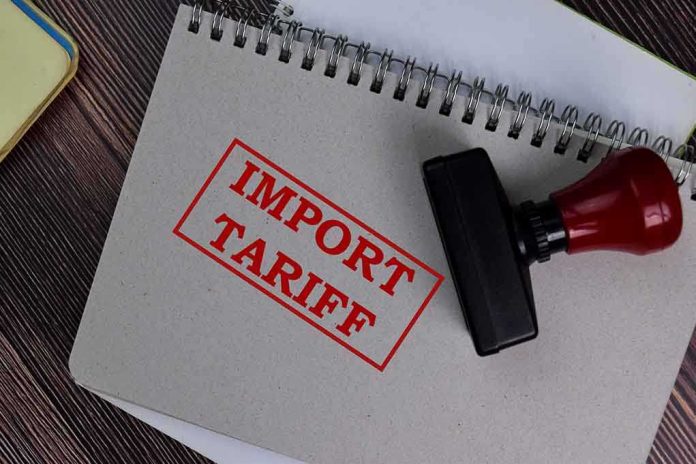
President Trump secures unprecedented access to Vietnamese markets for U.S. goods in exchange for a 20% tariff on Vietnamese imports, striking a blow against Chinese transshipping practices.
Key Takeaways
- Vietnamese exports to the U.S. will face a 20% tariff, while goods transshipped through Vietnam will incur a steeper 40% tariff
- U.S. products gain tariff-free access to Vietnamese markets, creating new opportunities for American manufacturers
- The agreement replaces a previously imposed 46% tariff and grants Vietnam a 90-day reprieve for compliance
- Vietnam is crucial to the U.S. supply chain, accounting for approximately 25% of U.S. shoe production, particularly athletic footwear
- The deal specifically targets China’s practice of routing goods through Vietnam to evade U.S. tariffs
America First Trade Policy Delivers Results
President Trump has negotiated another significant trade victory for American workers and businesses, announcing a groundbreaking new agreement with Vietnam. The deal strategically balances market access with fair trade practices, establishing a 20% tariff on Vietnamese goods entering American markets while imposing a punitive 40% tariff on products merely transshipped through Vietnam. Most importantly, the agreement secures complete access to Vietnamese markets for American products without any tariffs, creating unprecedented opportunities for U.S. manufacturers to expand their reach in Southeast Asia.
The agreement comes after direct negotiations with Vietnam’s General Secretary To Lam and represents a significant improvement from the initially proposed 46% tariff under Trump’s “Liberation Day” tariff structure. This arrangement reflects President Trump’s commitment to reciprocal trade relationships that protect American industry while opening new markets. The deal temporarily suspends previous tariff threats, giving Vietnam a 90-day window to demonstrate compliance with the new framework and address ongoing concerns about intellectual property theft and transshipment abuses.
The details within the trade agreement are unique. President Donald Trump has announced a trade agreement between the USA and Vietnam. Interestingly Vietnam will face a 20% tariff rate (baseline) and a 40% tariff rate on transnational shipping.
The 40% transnational shipping… https://t.co/KNaLz4FUp7
— TheLastRefuge (@TheLastRefuge2) July 2, 2025
Targeting Chinese Circumvention Through Vietnam
A central component of the new trade framework specifically addresses the problem of Chinese manufacturers using Vietnam as a backdoor to evade U.S. tariffs. U.S. officials have long alleged that China routes goods through Vietnam, which are then deceptively labeled as “Made in Vietnam” to bypass American trade restrictions. The new 40% transshipping tariff creates a powerful disincentive for this practice, representing President Trump’s strategic approach to closing loopholes that have allowed China to undermine American manufacturing through unfair trade practices.
“Vietnam will pay the United States a 20 percent tariff on any and all goods sent into our territory, and a 40 percent tariff on a Transshipping,” said U.S. President Donald Trump
Vietnam’s Government Office responded to these concerns by holding an emergency meeting to address U.S. concerns over intellectual property violations and transshipment abuses. This demonstrates the effectiveness of President Trump’s firm negotiating stance, which has compelled Vietnamese officials to take concrete action against practices that have disadvantaged American workers. The trade relationship between the U.S. and Vietnam has grown significantly, with total goods trade estimated at $149.6 billion in 2024, though with a substantial trade deficit of $123.5 billion that this new deal aims to reduce.
Impact on American and Vietnamese Industries
The new trade framework will have significant implications for various sectors, particularly the footwear industry. Vietnam has become essential to America’s footwear supply chain, especially for athletic shoes, with the U.S. importing 274 million pairs from Vietnam in 2024 alone. Industry representatives have expressed cautious optimism about the deal, recognizing that while the 20% tariff is higher than they might prefer, it represents a substantial improvement over the initially threatened 46% rate that would have devastated the supply chain.
“Vietnam is essential to the U.S. footwear supply chain, especially for athletic shoes. In 2024, we imported 274 million pairs from Vietnam, accounting for over half of all athletic footwear imports by volume and value,” said Matt Priest
For American exporters, the agreement opens exciting new possibilities in Vietnam’s growing market, particularly for automobile manufacturers. Vietnamese consumers have shown increasing interest in American-made SUVs and other vehicles, which will now enter their market without any tariff barriers. This creates a significant competitive advantage for U.S. manufacturers while maintaining appropriate protections for American markets. The deal demonstrates President Trump’s commitment to negotiating trade agreements that create real opportunities for American businesses while ensuring fair treatment in international commerce.
Part of a Broader Trade Strategy
The Vietnam agreement is part of President Trump’s comprehensive approach to restructuring America’s international trade relationships. Negotiations are currently underway with 14 other countries, including major economic powers like India, Japan, and Mexico. A trade deal with the United Kingdom has already been finalized, and Trump has hinted at a potentially “very big” agreement with India, another significant footwear production hub. These negotiations demonstrate the administration’s commitment to addressing America’s trade imbalances with countries across the globe.
With the July 9 deadline for some negotiations approaching, the Vietnam deal showcases President Trump’s ability to secure favorable terms through tough but fair negotiations. The agreement balances the needs of American consumers with the imperative to protect American jobs and manufacturing capacity. By standing firm on core principles while remaining open to mutually beneficial arrangements, the administration has created a framework for trade that puts American interests first while respecting the legitimate economic aspirations of our trading partners.







